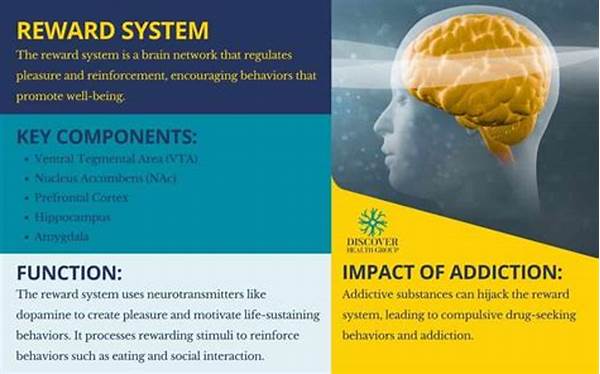
Reward System And Addiction
- Daniel Anderson
- 0
- Posted on
Understanding the intertwined relationship between the brain’s reward system and addiction is crucial in today’s fast-paced, dopamine-driven world. Imagine the brain’s reward system as the very thing that makes life sweet, a kind of internal cheerleader urging us on with a high-five. This internal mechanism is what prompts us to repeat actions that bring pleasure or satisfaction, be it eating chocolate cake, checking social media, or achieving a big work milestone. Yet, this very same system can sometimes lead us astray, nudging us towards addiction. The allure of short-term pleasure can often overshadow long-term well-being, and understanding this paradox is the first step toward managing it.
Read Now : Coping Strategies For Post-breakup Resilience
How the Reward System Fuels Addiction
Alright, so picture your reward system as the DJ spinning tracks in your brain’s dance club, highlighting the catchy beats that make you feel all woozy with joy. Every time you do something pleasurable, this DJ drops a dopamine track, and boom, you’re hooked. That’s how addiction sneaks in, turning everyday fun into a constant need for an encore. With the reward system as its wingman, addiction says, “Hey, remember how cool that was? Let’s do it again!” But like wearing the same outfit every day, what starts as exciting can quickly become routine. This dynamic duo keeps you chasing those highs, even when the thrill’s long gone.
The Downside of the Reward System and Its Link to Addiction
1. Dopamine Tango: Your reward system craves dopamine, the feel-good chemical, and addiction loves making it rain like a dopamine monsoon.
2. Habit Loops: The reward system’s like a playlist on repeat. Soon enough, you’re dancing to the same addictive tune daily.
3. Cravings Galore: With addiction, the reward system turns up the craving volume to eleven – it just can’t chill.
4. False Promises: The reward system is slick, promising more than it can deliver, especially when addiction pulls the strings.
5. Risky Business: Engaging in risky behaviors is part of the reward system’s thrill, and addiction seizes this with both hands.
Sweet Rewards and Bitter Truths
It’s wild how the brain’s reward system is at once our ally and our Achilles’ heel. It’s the hero delivering feel-good dopamine hits and simultaneously the villain when addiction creeps in. We tend, as humans, to seek out the sweet rushes it gives us, and that’s where the danger lies. The cycle of reward and addiction can become an ongoing loop – always spinning, always pulling us deeper – and the battle to break free is real. This reward-addiction rollercoaster often leaves people grappling with repercussions they never saw coming, all while chasing that elusive high for just one more spin on the ride.
Read Now : Mindfulness Practices For Stress Control
Understanding this duality helps explain why some people fall into the clutches of addiction, while others don’t. Recognizing the seductive siren call of the brain’s reward system can help keep you in control rather than captive. Education is key in this game; the more we know about how this system operates, the better we can handle it.
Navigating the Reward System and Addiction Maze
1. Dopamine Rush: The reward system craves the dopamine rush, making addiction’s allure hard to resist.2. Habit Train: Once reward becomes routine, addiction climbs aboard for the ride.3. Craving Cycle: The reward system spikes cravings, adding fuel to addiction.4. Sneaky Promises: Addiction whispers sweet, deceptive promises via the reward system.5. Risky Highs: Both are adrenaline junkies, thriving on high-risk thrills.6. Freedom Quest: Breaking free involves rebooting the reward system.7. Learning Curve: Knowledge of this system provides tools against addiction.8. Balance Beam: Balancing reward with responsibility tames addiction.9. Mindful Moments: Awareness diminishes the reward system’s stronghold.10. Help Networks: Support systems counteract the reward-addiction link.
The Internal Tug-of-War: Reward System and Addiction
It’s like balancing on a seesaw, one end being the reward system and the other, the grey shadow of addiction. Picture this: every time you’re tempted by a chocolate bar or another episode of your favorite series, that’s the reward system egging you on, promising that sweet dopamine high. But when it becomes about needing more, when that one episode spirals into a whole season in one sitting, addiction is the culprit whispering in your ear. It’s this back and forth, a real tug-of-war, where what starts as an innocent treat can sneakily evolve into something much harder to break free from. Recognizing these cues is crucial, as is having the will to rock the boat and keep it balanced before addiction tips the scales too far.
The Brain’s Playlist and the Cycle of Addiction
When the brain’s reward system keeps replaying the greatest hits, those dopamine tracks, you’re on a never-ending cycle. These addictive beats make it tough to hit pause and take control. It’s not just about getting momentarily lost; it’s about the potential for these beats to turn daily life into a consistent groove of seeking more rewards. Understanding this playlist, knowing when addiction tries to add a song, and consciously choosing which beats to entertain can shift the power dynamics. It’s about mastering that remix – giving the reward system its due without joining in addiction’s constant encore cries – and finding harmony in the sounds of everyday life.